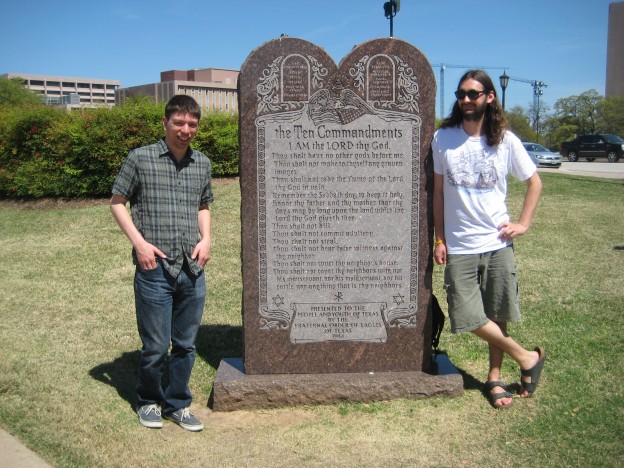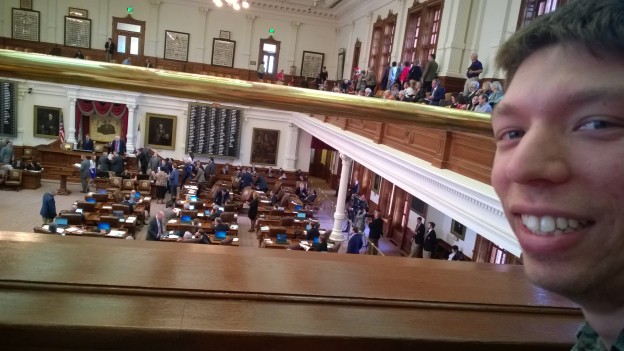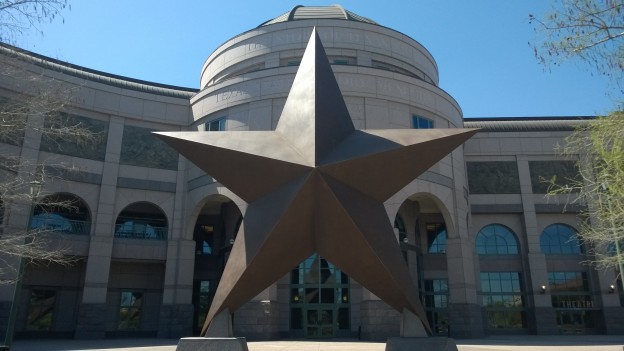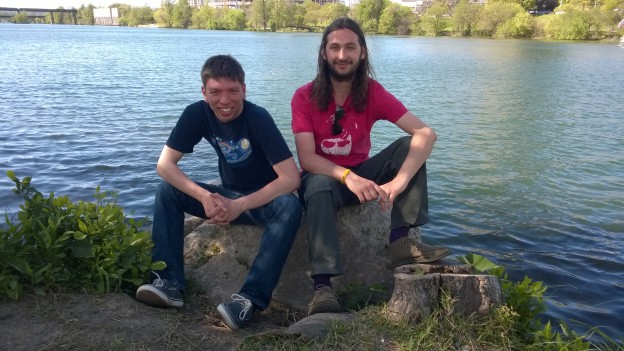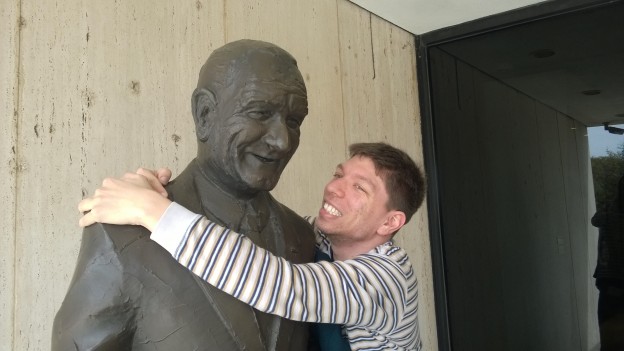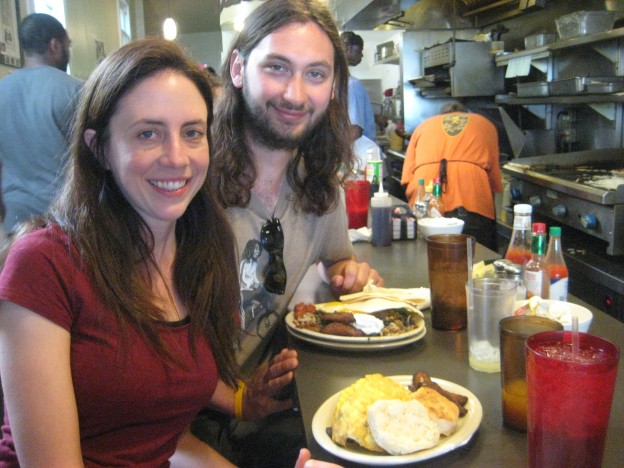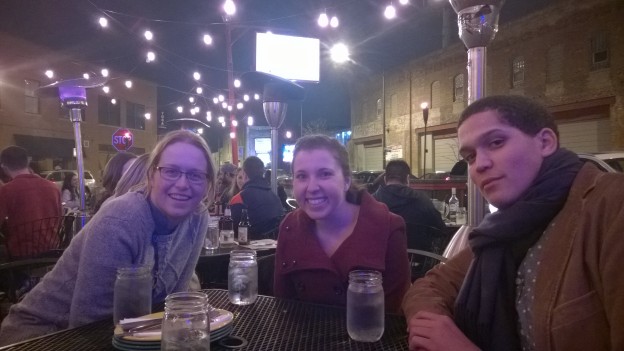I have a jokey conspiracy theory that Scientology is just a front organisation, cobbled together by other world religions to improve their reputations. It’s easy to declare that the idea of Lord Xenu isn’t inherently more ridiculous than an eternal dinner party in heaven, but the Church of Scientology gives people the heebie-jeebies in a way that the Archbishop of Canterbury never will. And after spending Tuesday evening with the Hubbardites, it’s easy to see why.
The adventure began after mistakenly receiving a Golden Age of Tech II DVD in the mail. We enjoyed it so much that we went binge-watching Scientology documentaries, concluding with HBO’s new Going Clear film a few weeks ago. (Sad fact: plans to broadcast it in the UK are running into trouble because the recent libel law reforms don’t cover Northern Ireland. This needs to get fixed.) So how better to round off the experience than a visit to their centre in Chicago?
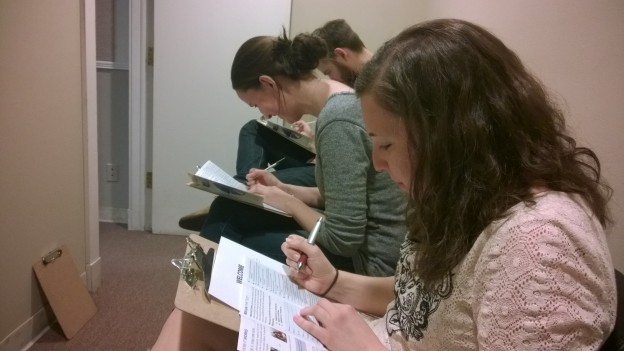
Taking the ‘personality test’
Now I admit: four prospective customers arriving together is a bit of a stretch, and I’m sure they smelled a rat. And as soon as we mentioned the Golden Age of Tech II they were immediately agitated, stressing repeatedly that we “shouldn’t have got that” and “it won’t have made any sense”. As many others have noted, Scientology is the only ‘religion’ which jealously guards its belief system from outsiders.
Nonetheless, they were welcoming enough, and quickly offered us the famous ‘free personality tests’ which we gratefully accepted. This is termed the Oxford Capacity Analysis, presumably to suggest a (bogus) connection with the university – a neat touch, unless you went to Cambridge, in which case it’s simply off-putting. The test is also dated to 1978, and it shows. “Do you believe the modern ‘prison without bars’ system is doomed to failure?” it asks, confusing 21st century Americans who notice rather a lot of bars around their prisons. I also had to decode the meaning of the ‘color [sic] bar’ (thanks, History GCSE!).
Even harder to answer are questions about how other people perceive you: is your voice monotonous? Do people think you talk too much? Do they criticise you to others? As far as I’m concerned, my friends and acquaintances have (presumably) always had the good manners to swap notes on how terrible I am behind my back, and as a sensitive soul I’d prefer it to stay this way. But like someone who corners you in a dark alley and asks for the time, the searing obviousness of the ploy feels insulting. At least go to the effort to hand-make some insecurities for me, rather than a cookie-cutter multiple choice quiz.
Anyway, after the test we were led into a small, darkened room to watch an introductory video about the history of Dianetics. (In another blunder, it transpired afterwards that they actually showed us the ‘wrong one’ – I hope someone senior in the Church is reading this.) With acting worse than a Star Wars prequel, we were led through the early struggles of Scientologists to gift Dianetics to the people in the 1950s. To give due deference to L Ron Hubbard, who might as well wander about with ‘cult of personality’ written on a sandwich board, you only see the back of his head. You do see, in a particularly choice moment, a gathering of the American Psychiatry Association – Scientology’s chief villains – wearing torn lab coats and performing lobotomies in some gloomy basement somewhere. But thankfully, Dianetics becomes a worldwide sensation anyway, and soon everyone is putting it into practice in all walks of life.
Hang on. Dianetics, just to be clear, is a watertight theory with a 100% success rate of mind-over-matter medical healing. The central character in the film avoids getting his infected leg amputated after a few bedside chats with Hubbard, for goodness sake. And then in the following decades it sweeps the world. But isn’t this the same world I’ve been living in for the past 25 years? Why have I been wasting money on dentists if this has already taken over?
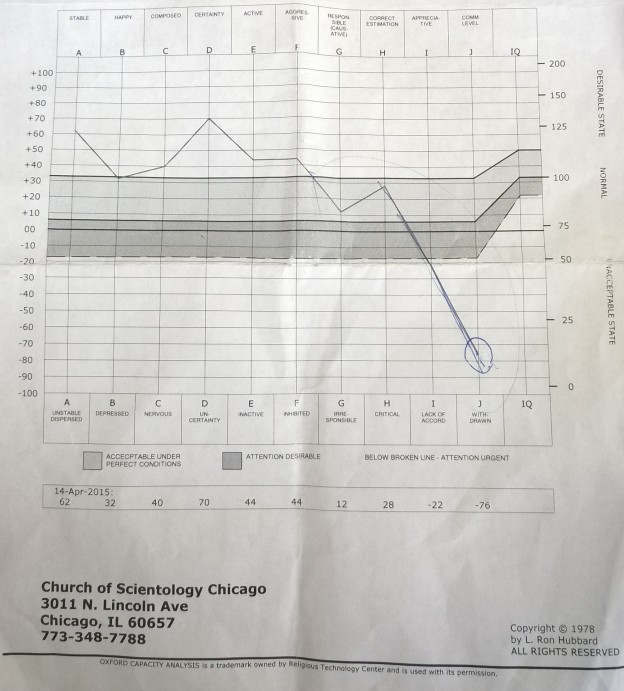
My results
Lay these thoughts aside for a moment, because it’s time for the test results! For this we were separated for one-on-one discussions – not a particularly relaxing prospect. This tension heightened when Catherine was accused of swapping answers with me, and I was challenged for saying that my biggest Life Problem (capitalisation © Church of Scientology) was the quality of American cheese in supermarkets.
“Is this really your biggest life problem?”
“Have you ever tried American cheese? It’s a problem.”
“I’ve tried lots of cheese. But this speaks to your test results: you don’t admit your true feelings to others.”
Yes, as you can see above, I score relatively well for ‘stable’ and ‘happy’ and ‘aggressive’ (come to your own conclusions about why ‘aggressive’ is at the positive end of the scale) but am let down massively by my withdrawn nature. I am, to speak precisely, -76 out of -100, which sounds perilously close to lock-me-in-a-room-and-shut-the-door territory. “Attention urgent” , the test says, although really this felt more like a nationality test than anything else. Admitting your true feelings to others is a slippery slope to Americanisation, and in any case, it doesn’t really equate to ‘shy’.
“Do you feel shy?”
“Not really…”
Silence followed, and to move things along I felt compelled to cold-read myself. “I guess, when there’s a bunch of people I don’t know already, I feel less confident than among my friends…” She nodded, approvingly. And then tried to sell me a book.
If this doesn’t feel like a church to you, that’s exactly the point. There is something mindblowing about the historical twists and turns of religions: that the outcome of arguments at the Council of Nicaea in 325 CE (!) helped decide what millions of Americans pray about every Sunday is as good an argument as any for why history is pretty fucking cool. In contrast, the intellectual lineage of Scientology is dreary 1950s psuedoscience and the “what type of thinker are you?” language you expect at a management consultancy ice-breaker. To what extent is Scientology’s limited success simply the remnants of a post-war moment: a new wave of college kids being exposed to faddish philosophies for the first time, and an enthusiasm for science and technology without enough popular understanding of what ‘science’ really means?
As we left, we all received free copies of Hubbard’s The Way to Happiness booklet. And so to end on a note of unity with Scientology, I wanted to quote the conclusion of chapter 8 (murder):
The way to happiness does not include murdering or your friends, your family or yourself being murdered.
Well at least we can all agree on that, right guys?
Jesus paid it all,
All to Him I owe;
Sin had left a crimson stain,
He washed it white as snow.(Spotify)
We huddle along our row as the band plays. The balcony affords an excellent view of the auditorium: not full, but certainly not sparsely populated either. This is Willow Creek Community Church in Barrington, Illinois. It’s less than an hour’s drive from Chicago and averages 24,000 attendees over a weekend, according to Wikipedia, making it America’s third largest church. And Ellen has kindly driven me, Randi and Kannan to have a look.
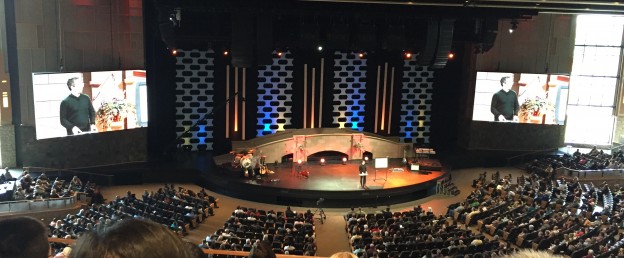
I’ve a feeling we’re not in the C of E anymore
After the half hour concert is over, the ‘Director of Section Communities’ runs through some administrative items and monetary collections. Those watching online are encouraged to donate through the website, and everyone is shown a glossy video of the international projects the church is involved in. But soon we move on to Steve Carter, teaching pastor, whose talk this week will be on ‘the reality of heaven’. (The whole thing is archived on their website.)
I quite like Steve. I’m frequently frustrated when religious leaders fail to discuss the actual implications of ideas like ‘the afterlife’ outside of ritual or absurdly generalised metaphor. Steve certainly can’t be accused of that – he even draws a diagram, so you know exactly where everything sits.
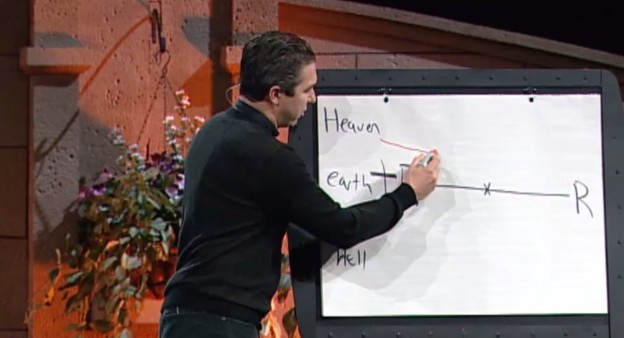
Heaven, Earth, Hell
Of course, the downside of not using absurdly generalised metaphor is being absurdly specific and literal. Taking our cues from CS Lewis, we envisage heaven through the Bible’s imagery of dinner parties, weddings, cities and concerts. “It doesn’t seem boring to me”, Steve declares, but it doesn’t take a great leap of imagination to wonder how many performances of Jesus Paid It All you’d be able to take. Alas, when it comes to hell he reverts to the now ubiquitous “separation from God” soundbite, quickly drawing a veil over eternal damnation. He also tells a story about discovering that his long-lost biological father had died, but not before coming to the faith, and thereby raising the prospect of joyful reunion in heaven. Which is all very well, but who asks the obvious question: what if he hadn’t?
After the sermon, Randi and I queue up to ask questions. She wants to know if Jews get into heaven (it’s unclear), and as ever I’m curious if his God would grant my dying wish to opt-out of any afterlife altogether. Steve doesn’t pretend to have concrete answers, but can’t understand why anyone would want that. “In my experience, people who say that are really motivated by a fear, deep down, that they wouldn’t get in.” And here we stand smiling at each other, stranded on opposite banks of comprehension. Can it really be true that he doesn’t understand the torture of immortality? I almost want to start going to their Alpha courses to try and bring him round. But I think church conversions are only supposed to happen in one direction.
On the drive back, Randi is unimpressed with the lax demands placed on the congregation. The most we ever heard from the Bible at this big, non-denomination gathering was short quotes appearing as captions on giant screens – a long way from multi-hour Torah readings. In a competitive marketplace of religion, the distinction between worshipper and customer is not always clear. Even the song lyrics are full of monetary metaphor: Jesus paid, we are ransomed.
I’m sure those who run Willow Creek would say that church ought to be a joyful, celebratory experience. It certainly seemed so for its parishioners – a more diverse crowd than you often see acting together in Chicago, it’s fair to say. There’s even a sign language translation for the deaf. But in the end, I’m not much moved whether a church is dour or rich. It’s the ideas which are more interesting, and no matter how catchy the song, sin’s ‘crimson stain’ still invites a question: are we really born broken? Do we need to be ‘saved’? And who wants to live forever?
In Part 2, we’ll visit the Church of Scientology for some ‘free personality tests’.
I almost didn’t make it to Austin. Having almost passed out on the train to the airport, I arrived just in time to empty my guts into the nearest toilet, before shuffling through security and onto the plane in an ugly state. Thankfully, the woman assigned to the seat next to me quickly fled in self-preservation, and I was left alone to occupy the row in a foetal position. But this only increased my happiness at seeing Josh and Anna’s faces again when my cab pulled up by our Airbnb home that night. Who’d have thought we’d be reuniting in the capital of Texas?
Mock if you will, but my favourite part of Austin was the Texas Legislature, which is admirably open and welcoming to the public. We strolled into the gallery above the House of Representatives first, who were debating an amendment to allow texting in a car which had come to a complete stop. “The data show that this rule costs lives” one Representative began, before being interrupted by another demanding a source. An assistant duly scurried in with a piece of paper, although not before the first guy clarified meekly that he was still in support of the rule change, despite the higher death rate. It passed by a landslide.
Other highlights included the state’s history museum and the LBJ Presidential Library, at either ends of the University of Texas campus. In between, a pro-Palestine demonstration was loudly and successfully gathering attention away from an Israeli block party, which says something about the liberal Austin vibe. We drove out of the city one morning so we could go swim in the Pedernales River, waited under the Congress Avenue bridge for the famous flight of the city’s bats at dusk, and spun about a thousand bat puns out of the days which followed.
Austin was a great city, but New Orleans was the more special and memorable of the two. We drove – by which I mean, Anna drove us – through Texas and Louisiana in a day, stopping at a farewell-to-Texas steakhouse (where our servers danced and tried out their British accents) and at Louisiana’s welcome centre, where they hand out free coffee and tell you to beware of alligators. New Orleans, though, is clearly a place unto itself. It’s almost impossible to capture properly in photographs, because the most wonderful thing is all of the free music which pours out of every bar and street corner. We wandered from bar to bar each night, drinking Purple Haze and soaking up the atmosphere of blues and jazz.
As you can see, we also went on a swamp tour – not to be missed – and ate all of the right foods. Crawfish etouffee, fried alligator, beignets, snowballs: distinctive cuisine is the other reason to visit NOLA, and it did not disappoint. I should clarify, too, that the creepy display of Confederate flags above was an aberration, and outside the city. The worst thing we saw in New Orleans itself was the trashier end of Bourbon Street, where police led a man out of a strip club while very bored looking strippers looked on. That said, we didn’t wander too far from the historic French Quarter, except to catch the streetcar to and from our house in the Irish part of town. There were plenty of references to Hurricane Katrina, but how much the city is still recovering was left mostly to our imaginations.
More than most American cities, though, New Orleans just feels old and enduring: layers of French and Spanish history pile up in refreshingly narrow, built-before-the-car-came streets. Whenever you make it to visit – and you will want to visit sometime – it’ll be here, ready with music and life.
So: my first trip to the South is complete, and two more states can be scratched off the map. (That’s not a metaphor, it’s an actual scratch map.) More American exploration on the way!
Two bittersweet theatre trips these past few weeks. Scheduling snafus mean I will miss the next two months of Common Room – so if you’ve always wanted to go without the risk of bumping into me, now’s your chance. Meanwhile, here are my final updates for a while…
Four is a well-acted revival of a 1998 play. It’s a quiet, unflashy piece about two couples getting to know each other – a dose of realism without becoming banal – very ‘theatre’, in a good way. The theatre group made a big deal of the fact that in the mid-1990s no one had recourse to a smartphone during an awkward conversation, but I was actually more struck that no gay relationship in theatre avoided at least a passing reference to AIDS. It feels like a very long time ago now. I also saw The Capitano Must Die, an Italian commedia dell’arte (think masked comedy with a generous dose of bawdy slapstick) which has absolutely no interest in realism whatsoever, but is funny and jolly and quite wonderful too.
I also hosted the second instalment of the Salon, inviting a bunch of great folks round for Indian takeaway and Four Lions. It’s at least my third time watching this film, and I still love it. It’s not even particularly discussion-worthy or controversial or meaningful. It’s just great.
I’ll leave you with this photo from one evening at a Cuban restaurant, during the brief window where Chicago experienced spring and it was possible to eat outside. Suits me, though, because tonight I’m flying to Austin. Can’t wait 😀

